Sunnyvale Dentist
Preventive & Conservative Dentistry
Complete Oral Care including Invisalign
Services
Contact
Address
877 W. Fremont Avenue, Suite A-2
Sunnyvale, CA 94087. Map it!
Phone
(408) 524-5505
Hours
Mon, Wed Closed
Tue,Thu,Fri 7:30-3:30
Sat 8:00 AM-4:00 PM
Sun 9:00 AM-4:00 PM
Charity
Got a Question?
Social Networking
Patient Education
Patient Feedback
Patient Records
Fillings
Cavities or decay occurs when enamel and dentin in some instances get demineralized and infected due to bacteria. Filling is a procedure in which this infected and demineralized part of the tooth/teeth is removed and the space filled with a choice of filling material.
Thanks to advances in modern dental materials and techniques, dentists have more ways to create pleasing, natural-looking smiles. Dental researchers are continuing their often decades-long work developing materials, such as ceramics and polymer compounds that look more like natural teeth. As a result, dentists and patients today have several choices when it comes to selecting materials to repair missing, worn, damaged or decayed teeth.
These new materials have not eliminated the usefulness of more traditional dental materials, such as gold, base metal alloys and dental amalgam. That’s because the strength and durability of traditional dental materials continue to make them useful for situations, such as fillings in the back teeth where chewing forces are greatest.
What's Right for Me?
Several factors influence the performance, durability, longevity and cost of dental restorations. These factors include: the patient's oral and general health, the components used in the filling material; where and how the filling is placed; the chewing load that the tooth will have to bear; and the length and number of visits needed to prepare and adjust the restored tooth.
With so many choices, how do you know what's right for you? To help you better understand what's available, here are the advantages and disadvantages of commonly used dental restorations.
The ultimate decision about what to use is best determined by the patient in consultation with the dentist. Before your treatment begins, discuss the options with your dentist.
Types of Dental Restorations
There are two types of dental restorations: direct and indirect.
Direct restorations are fillings placed immediately into a prepared cavity in a single visit. They include dental amalgam, glass ionomers, resin ionomers and some resin composite fillings. The dentist prepares the tooth, places the filling and adjusts it during one appointment.
Indirect restorations generally require two or more visits. They include inlays, onlays, veneers, crowns and bridges fabricated with gold, base metal alloys, ceramics or composites. During the first visit, the dentist prepares the tooth and makes an impression of the area to be restored. The impression is sent to a dental laboratory, which creates the dental restoration. At the next appointment, the dentist cements the restoration into the prepared cavity and adjusts it as needed.
Amalgam Fillings
Used by dentists for more than a century, dental amalgam is the most thoroughly
researched and tested restorative material 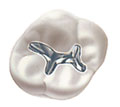 among
all those in use. It is durable, easy to use, highly resistant to wear
and relatively inexpensive in comparison to other materials. For those
reasons, it remains a valued treatment option for dentists and their patients.
among
all those in use. It is durable, easy to use, highly resistant to wear
and relatively inexpensive in comparison to other materials. For those
reasons, it remains a valued treatment option for dentists and their patients.
Dental amalgam is a stable alloy made by combining elemental mercury, silver, tin, copper and possibly other metallic elements. Although dental amalgam continues to be a safe, commonly used restorative material, some concern has been raised because of its mercury content. However, the mercury in amalgam combines with other metals to render it stable and safe for use in filling teeth.
While questions have arisen about the safety of dental amalgam relating to its mercury content, the major U.S. and international scientific and health bodies, including the National Institutes of Health, the U.S. Public Health Service, the Centers for Disease Control and Prevention, the Food and Drug Administration and the World Health Organization, among others have been satisfied that dental amalgam is a safe, reliable and effective restorative material.
Because amalgam fillings can withstand very high chewing loads, they are particularly useful for restoring molars in the back of the mouth where chewing load is greatest. They are also useful in areas where a cavity preparation is difficult to keep dry during the filling replacement, such as in deep fillings below the gum line. Amalgam fillings, like other filling materials, are considered biocompatible—they are well tolerated by patients with only rare occurrences of allergic response.
Disadvantages of amalgam include possible short-term sensitivity to hot or cold after the filling is placed. The silver-colored filling is not as natural looking as one that is tooth-colored, especially when the restoration is near the front of the mouth, and shows when the patient laughs or speaks. And to prepare the tooth, the dentist may need to remove more tooth structure to accommodate an amalgam filling than for other types of fillings.
Composite Fillings
Composite fillings are a mixture of glass or quartz
filler in a resin medium that produces a tooth-colored filling. They are
sometimes referred to as composites or filled resins. Composite fillings
provide good durability and resistance to fracture in small-to-mid size
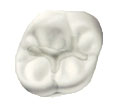 restorations
that need to withstand moderate chewing pressure. Less tooth structure
is removed when the dentist prepares the tooth, and this may result in
a smaller filling than that of an amalgam. Composites can also be "bonded"
or adhesively held in a cavity, often allowing the dentist to make a more
conservative repair to the tooth.
restorations
that need to withstand moderate chewing pressure. Less tooth structure
is removed when the dentist prepares the tooth, and this may result in
a smaller filling than that of an amalgam. Composites can also be "bonded"
or adhesively held in a cavity, often allowing the dentist to make a more
conservative repair to the tooth.
The cost is moderate and depends on the size of the filling and the technique used by the dentist to place it in the prepared tooth. It generally takes longer to place a composite filling than what is required for an amalgam filling. Composite fillings require a cavity that can be kept clean and dry during filling and they are subject to stain and discoloration over time.
Ionomers
Glass ionomers are translucent, tooth-colored materials
made of a mixture of acrylic acids and fine glass powders that 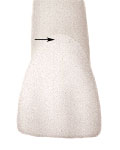 are
used to fill cavities, particularly those on the root surfaces of teeth.
Glass ionomers can release a small amount of fluoride that may be beneficial
for patients who are at high risk for decay. When the dentist prepares
the tooth for a glass ionomer, less tooth structure can be removed; this
may result in a smaller filling than that of an amalgam.
are
used to fill cavities, particularly those on the root surfaces of teeth.
Glass ionomers can release a small amount of fluoride that may be beneficial
for patients who are at high risk for decay. When the dentist prepares
the tooth for a glass ionomer, less tooth structure can be removed; this
may result in a smaller filling than that of an amalgam.
Glass ionomers are primarily used in areas not subject to heavy chewing pressure. Because they have a low resistance to fracture, glass ionomers are mostly used in small non-load bearing fillings (those between the teeth) or on the roots of teeth.
Resin ionomers also are made from glass filler with acrylic acids and acrylic resin. They also are used for very small, non-load bearing fillings (between the teeth), on the root surfaces of teeth, and they have low to moderate resistance to fracture.
Ionomers experience high wear when placed on chewing surfaces. Both glass and resin ionomers mimic natural tooth color but lack the natural translucency of enamel. Both types are well tolerated by patients with only rare occurrences of allergic response.
Indirect Restorative Dental Materials (Two or more visits)
Sometimes the best dental treatment for a tooth is
to use a restoration that is made in a laboratory from a mold. These custom-made
restorations, which require two or more visits, can be a crown, an inlay
or an onlay. A crown covers the entire chewing surface and sides of the
tooth. An inlay is smaller and fits within the contours of the tooth.
An onlay is similar to an inlay, but it is larger and covers some or all chewing surfaces of the tooth. The cost of indirect restorations is generally higher due to the number and length of visits required, and the additional cost of having the restoration made in a dental laboratory. Materials used to fabricate these restorations are porcelain (ceramic), porcelain fused to a metal-supporting structure, gold alloys and base metal alloys.
All-Porcelain (Ceramic) Dental Materials
All-porcelain (ceramic) dental materials include
porcelain, ceramic or glasslike fillings and crowns. They are used as
inlays, onlays, crowns and aesthetic veneers. A veneer is a very thin
shell of porcelain that can replace or cover part of the enamel of the
tooth. All-porcelain (ceramic) restorations are particularly desirable
because their color and translucency mimic natural tooth enamel.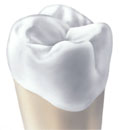
All-porcelain restorations require a minimum of two visits and possibly more. The restorations are prone to fracture when placed under tension or on impact. The strength of this type of restoration depends on an adequate thickness of porcelain and the ability to be bonded to the underlying tooth. They are highly resistant to wear but the porcelain can quickly wear opposing teeth if the porcelain surface becomes rough.
Porcelain-fused-to-Metal
Another type of restoration is porcelain-fused-to-metal, which provides strength to a crown or bridge. These restorations are very strong and durable.
The combination of porcelain bonded to a supporting
structure of metal creates a stronger restoration than porcelain used
alone.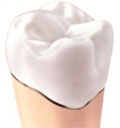 More of the existing tooth must be removed to accommodate the restoration.
Although they are highly resistant to wear, porcelain restorations can
wear opposing natural teeth if the porcelain becomes rough. There may
be some initial discomfort to hot and cold. While porcelain-fused-to-metal
restorations are highly biocompatible, some patients may show an allergic
sensitivity to some types of metals used in the restoration.
More of the existing tooth must be removed to accommodate the restoration.
Although they are highly resistant to wear, porcelain restorations can
wear opposing natural teeth if the porcelain becomes rough. There may
be some initial discomfort to hot and cold. While porcelain-fused-to-metal
restorations are highly biocompatible, some patients may show an allergic
sensitivity to some types of metals used in the restoration.
Gold Alloys
Gold alloys contain gold, copper and other metals
that result in a strong, effective filling, crown or a bridge. They are
primarily used for inlays, onlays, crowns and fixed bridges. They are
highly resistant to corrosion and tarnishing.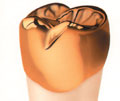
Gold alloys exhibit high strength and toughness that resists fracture and wear. This allows the dentist to remove the least amount of healthy tooth structure when preparing the tooth for the restoration. Gold alloys are also gentle to opposing teeth and are well tolerated by patients. However, their metal colors do not look like natural teeth.
Base Metal Alloys
Base metal alloys are non-noble metals with a silver appearance. They are used in crowns, fixed bridges and partial dentures. They can be resistant to corrosion and tarnishing. They also have high strength and toughness and are very resistant to fracture and wear.
Some patients may show allergic sensitivity to base metals and there may be some initial discomfort from hot and cold. However, due to their metal color, gold alloys do not look like natural teeth.
Indirect Composites
Crowns, inlays and onlays can be made in the laboratory
from dental composites.  These
materials are similar to those used in direct fillings and are tooth colored.
One advantage to indirect composites is that they do not excessively wear
opposing teeth. Their strength and durability is not as high as porcelain
or metal restorations and they are more prone to wear and discoloration.
These
materials are similar to those used in direct fillings and are tooth colored.
One advantage to indirect composites is that they do not excessively wear
opposing teeth. Their strength and durability is not as high as porcelain
or metal restorations and they are more prone to wear and discoloration.
